Season of the storm: Tulane football remembers Hurricane Katrina, 10 years later

At first, Israel Route couldn't tell where the television cameras were pointed. In the predawn hours of Aug. 31, 2005, the first news broadcast the Tulane cornerback had seen since Hurricane Katrina made landfall in New Orleans was playing across the screen in a Shreveport, La., area convenience store. Bleary-eyed and sleep-deprived, Route and his teammates struggled to make sense of what they saw. Tree branches floated across intersections. Road signs pointed in the wrong direction. Families were stranded on overpasses. Yet not one passenger in the Green Wave's bus caravan from Jackson, Miss., to Dallas had begun to entertain the idea he wouldn't soon be on his way home.
Most of Tulane's athletes had ridden out Katrina in a gym at Jackson State University with only a tenuous connection to the rest of the world. They had neither power nor cell service, and to glance outside and take in the storm's damage players had to pry open the windowless building's heavy metal doors. Still, 200 miles inland, Katrina seemed like any other hurricane, a phenomenon New Orleanians have rendered routine: Pack three days' worth of clothing, secure valuables, fight the contraflow traffic heading north.
That night in Shreveport—en route to their second temporary home in three days—players were anxious to see their city for the first time on television. They were unsure where the floods had crept until a few placed the footage. "That's Uptown," the crowd murmured. "There's the Circle K on Claiborne Ave." Someone pointed at the screen, and there was the small grocery store that sits across six lanes of traffic from the north end of Tulane's campus. It was submerged under five feet of water.
"We got back on the bus to Dallas, and it was dead silent," recalls quarterback Lester Ricard, who grew up an hour north of New Orleans in Denham Springs, La. "It was so surreal, what we'd seen. It looked like a horror film. You couldn't believe that this could actually happen to an American city."
Tulane's players weren't going home—not that week, not that month, not that season. Five hundred miles from Dallas, water continued to gush into New Orleans, and the university shut its doors for the fall semester. The NFL's Saints moved to San Antonio and went 3-13. The NBA's Hornets spent their season in Oklahoma City and finished 38-44. And Tulane, after contemplating canceling fall sports entirely, scattered. Programs relocated to Texas Tech, Texas A&M, SMU, Rice and Louisiana Tech, where the football team ultimately landed. What followed was a season born of heartbreak and fueled by chaos. The Green Wave went 2-9, played in 11 different stadiums and slept in a condemned dorm; yet, somehow, only three players transferred at year's end. The rest—call them loyal, dedicated or delightfully insane—returned to a decimated campus in a shattered city and became the foundation upon which their world rebuilt.
*****
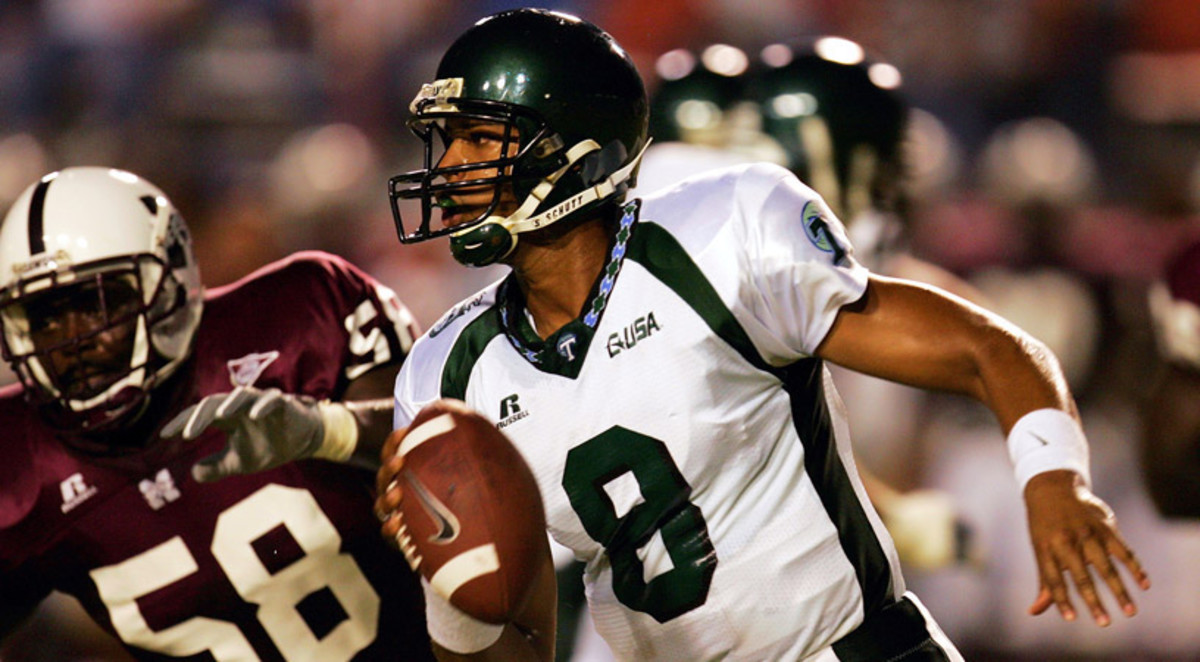
Ronald Martinez/Getty Images
In New Orleans, 4 a.m. is an hour for sleeping and for straggling, for using the final vestiges of darkness to find a way home from the bars that never close. On Aug. 27, 2005, it was one of the city's final hours of blissful ignorance as Hurricane Katrina riled herself up, a giant counterclockwise mess of moisture and wind, over the Gulf of Mexico. Still, as the storm was upgraded to Category 3 (it would reach Category 5 within 27 hours of the Category 3 designation), most New Orleanians remained unfazed: men spent the morning fishing, kids back-to-school shopping, joggers making the loop at Audubon Park. But Tulane athletic director Rick Dickson had been tracking the system for days, and the latest radar came as a gut punch. "That little cone was covering the entire Gulf," he recalls. "Oh my god."
By 10 a.m. outlying parishes (Big Easy-speak for suburbs) had implemented forced evacuations. Still, move-in day at Tulane was underway, and football players were assisting. By afternoon, as early clouds rolled in, Route remembers feeling thankful; a thunderstorm would be a welcome break from the oppressive heat. But university president Scott Cowen knew better. In an abridged convocation speech, he warned students to evacuate immediately. "Plan to be back in four or five days," he said.
The football team got a similar message from coach Chris Scelfo, who instructed players to pack for a few days and report to their facility the next morning. That night, players scattered. Ricard and tailback Matt Forte tagged along to offensive lineman Mike Parenton's family's Uptown home, where the three squeezed into one bed and spent the night beating one another up. It felt like the night before a spring break road trip.
When Tulane's buses—originally scheduled to take the team to its practice at the Superdome—rolled away from campus the next morning, they immediately hit traffic. New Orleans mayor Ray Nagin had ordered the first mandatory evacuation in city history. The caravan took five hours to get out of the metro area and another five to travel the remaining 175 miles to Jackson State, where the athletes were ushered into T.B. Ellis Gymnasium. The heat in the crowded room hung heavy, and air mattresses were scarce even after several local businesses donated supplies.
On Monday, as the first clouds gathered over Jackson, Cowen called Dickson. Katrina, back at Category 3 after reaching her peak over the Gulf, had whipped through New Orleans, and the university president, still on campus, told the AD the school had sustained damage but aimed to reopen by late September. Not long after that conversation, power went out in Jackson in the middle of a makeshift football workout, and that night whatever scarce communication the team had from New Orleans ceased. As the then-Category 2 storm surged through Mississippi, players watched the half-built wooden church across the street topple. They showered by flashlight, thankful for a few minutes of cool, oblivious that their city was drowning.
By early Monday morning in New Orleans, water had begun to rise on both sides of the Industrial Canal, a 5 ½-mile-long waterway that connects Lake Pontchartrain to the Mississippi River and separates the Lower Ninth Ward from the Upper Ninth and most of the rest of the city. In a matter of minutes, the Lower Ninth was under about seven feet of water, and by late morning St. Bernard Parish (a blue-collar delta of a suburb made up of 2,158 square miles of which 83% are water) was flooded, too, more than 10 feet submerged in spots. Then, at 2 p.m., officials confirmed a breach of the 17th Street Canal levee; floodwaters had rushed into much of New Orleans proper, including on to Tulane's campus.
On Tuesday, players learned they'd be traveling again, this time to Dallas. It was the first sign that the aftermath of the storm was worse than they'd imagined, but the team figured it was just moving beyond Katrina's warpath. That changed in Shreveport. "We can't go back," offensive lineman Troy Kropog remembers realizing, "and we have nothing set up going forward."
*****
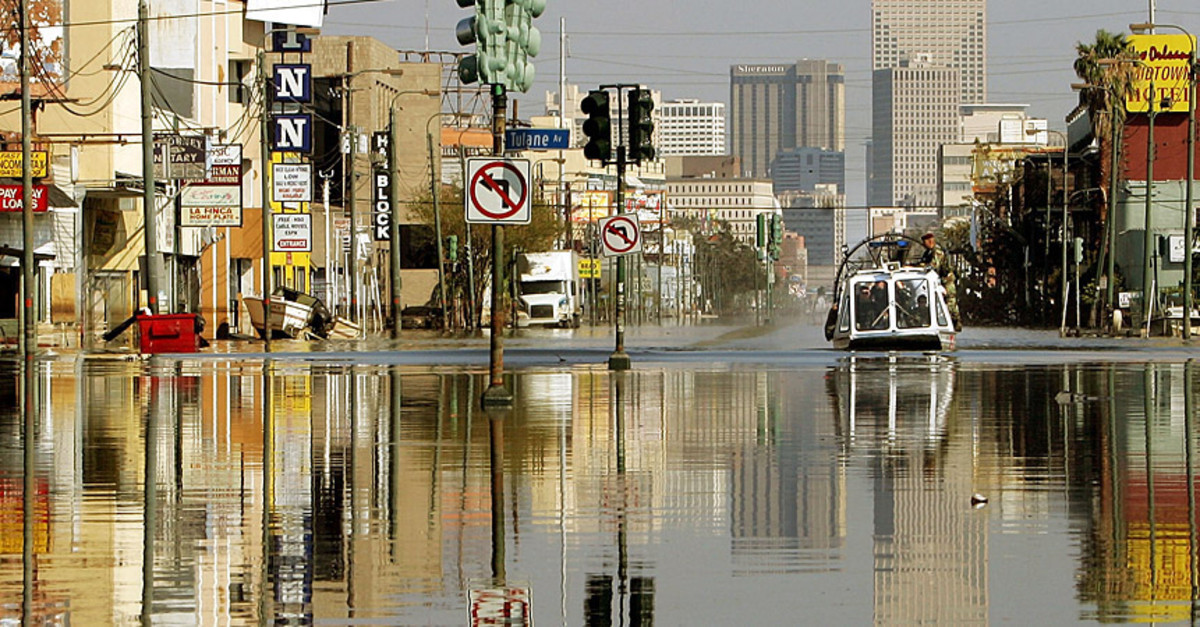
Mario Tama/Getty Images
Scelfo's first call from Dallas was to the NCAA. His players had sweated through the few clothes they'd packed and were hungry, having lived off elementary school-style boxed lunches and pizza in Jackson. "We had absolutely nothing," the coach says, and wanted to know what the NCAA would allow donors to provide. The NCAA said almost anything was fair game for donors. Scelfo and Dickson also asked for a ruling on poaching; with Tulane's season in question after the university determined it would close for the fall, rival coaches were trying to lure players like Forte and Ricard. Then-NCAA president Myles Brand complied, issuing a strong statement against what he termed "athletic looting" and emphasizing that transfer rules for players affected by the storm would not be relaxed. "There wasn't any playbook to pull this off," Dickson says.
The week the team spent at a Doubletree Hotel passed in a fog. Katrina churned north and dissipated. By Sept. 1 parts of New Orleans were under 10 feet of water, and the bulk of the Ninth Ward, Arabi, Gentilly, Lakeview, Mid-City, Hollygrove and Old Metairie neighborhoods were four feet or more submerged. Still, some lines of communication began to open as the last stragglers evacuated. Players tracked down missing family members—Ricard's uncle had been rescued off a Ninth Ward roof and wound up in Dallas, too—and some parents were able to visit. Many players assumed they'd lost everything. All they wanted to know was where they were going, if they'd be playing and how they'd move on.
The team spent 13 days in Dallas, eating at SMU, practicing at Jesuit High School, shopping for necessities with donated funds at Dillard's and throwing one epic party in the hotel's conference room. "Club Doubletree," they called it, having rigged a projector to fill the room with ambient blue light and recruited a gaggle of girls. Little did they know that night would be the highlight of their semester. "Everything after that spiraled downwards at an obscene rate," Kropog says.
Two days later the team got word: It would play its season entirely on the road while based in Ruston, La. (pop. 22,000). Louisiana Tech had offered the top floors of a condemned dorm to house the team, plus it had ample gym space and could guarantee Tulane sufficient time on its fields. The Green Wave had only practice helmets—white, sans decals—and road uniforms, enough gear to keep the roster clothed and looking halfway official. Cowen and Dickson, who both believed the school should field fall sports, were sold. To compete, Cowen believed, would be to remind the country that Tulane existed while its doors were shut. "We were playing for something bigger than ourselves," Route says. "We were playing for the city of New Orleans, and being able to play football, something we love, brought a little normal to what we were going through."
Logistically, the season was mayhem. Tulane's opener at Southern Mississippi was postponed until November, and its Week 2 matchup against Mississippi State was relocated to Shreveport. If an alternate location was scheduled more than a few weeks in advance, Dickson says, it was a minor miracle. The team would go on to play home games in Baton Rouge, La.; Lafayette, La.; Mobile, Ala.; Monroe, La., and Ruston. Senior Day, in Monroe, saw fewer than 100 fans in the stands, and the team's biggest cheering section came in Ruston, where Louisiana Tech's students came out to support their unlikely new classmates. Road games saw empty visitor's sections and home games entirely empty stadiums. Players tried to tune out the silence, but eventually it overwhelmed.
*****
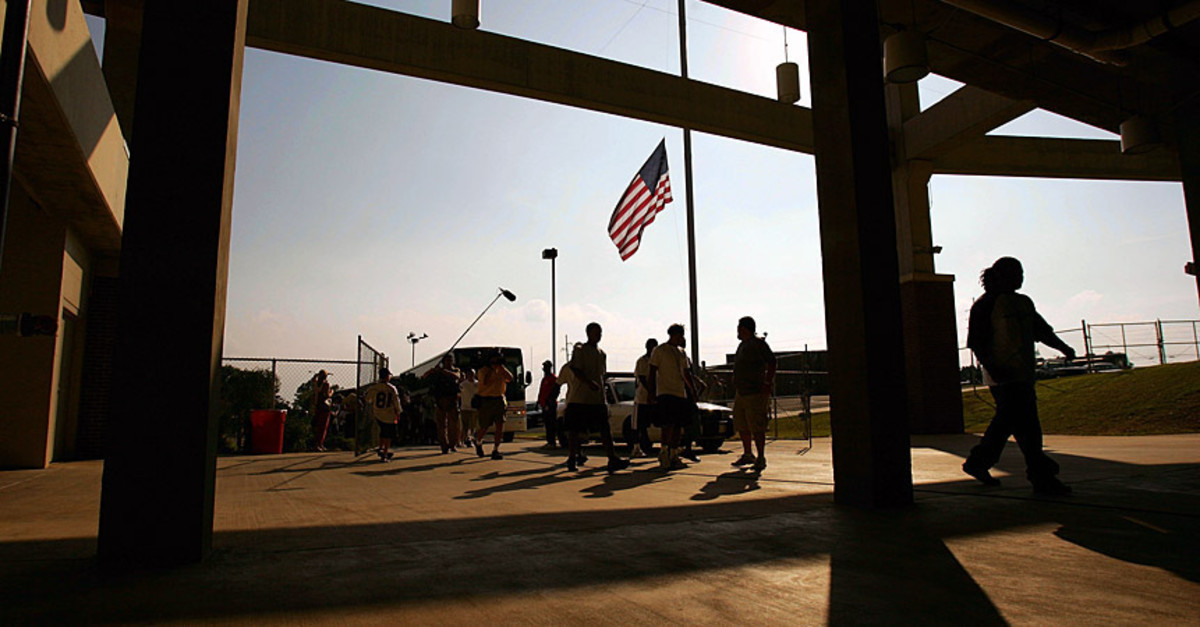
Ronald Martinez/Getty Images
Ten years later the weeks the team spent in Ruston have been reduced to a series of buzzwords. It's easier to parse the weirdness of it all that way, to rattle off the list of odd without quite spiraling back into it all. Dorms, for instance: muddy water in the faucets, strange neighbors on the floors below. Louisiana Tech hosted hundreds more evacuees in the same building as the athletes, and though some—like the preteen who followed players around and rapped—became friends of the program, more were nuisances. One man would get drunk and fall asleep in players' beds. Others swiped electronics from behind players' unlocked doors. Sometimes monitors patrolled the stairways to keep groups separate. Other times they didn't.
And then there were the classes. This one gets a laugh: bowling, coaching softball and obscure histories were the norm after Tulane players realized their eligibility was secure. Credits would transfer, but many classes were pass/fail, and some players barely attended at all, taking advantage of the fact that the coaching staff gave them Sundays, Mondays and most of Tuesdays off. Much of the roster used those days to escape, to see family or to spend 48 hours blowing off steam at LSU's bars. In retrospect, players are baffled by the free time. They wonder why they weren't trying to salvage a season they had committed to play. But Scelfo stands by his schedule, constructed just as much for the players' sanity as it was for the coaches, who were equally worn down.
Also, walking: to practice, from it, to Wal-Mart, in the heat. At first, only the lucky few players whose parents delivered their cars had wheels, and even by semester's end the majority of the team was without transportation. The walk from the dorm to the locker room to the field was more than a mile, and most players slogged through the heat in their pads. Kropog, who got his truck out of New Orleans early in the semester, recalls loading down the cab and bed with fully padded players, so heavy the body of the car nearly scraped the ground.
But Greg Stewart's buzzword is the strangest of all, a bizarre symbol of the whole damned disaster: suit. The team's doctor didn't want, and couldn't bring himself, to pack one. It was midseason, and he had just returned from Ruston to New Orleans, where he was based among the ruins. He caught a nap and got a call. "Beckman got shot," the coach on the line said, and Stewart was awake. Chris Beckman was Tulane's punter, shot by an elephant-gun bullet that had ricocheted off a sign and landed in his liver. The team needed Stewart back in Ruston to advise on treatment, so he tossed the belongings he'd just unpacked into a duffel bag. "I had to make the decision: Do I take a suit with me?" Stewart recalls. "If he dies, I have to have a suit with me so I can go to his funeral. It was just one of those things [where] I said, 'He's not going to die. He cannot die. We cannot handle one more thing.'" (Beckman did, in fact, survive.)
But most everyone's telling of the Katrina season builds to one weekend. It was Oct. 1, which was supposed to be Tulane's homecoming, but homeless teams have no such luxury. The game against Southeast Louisiana had been moved to LSU's Tiger Stadium, and the trip to Baton Rouge would bring the team closer to New Orleans than it had been since its evacuation. The Green Wave spent the night before the game at Scelfo's empty country club east of New Orleans, and on their way they caught glimpses of the devastation—most players' first since the storm. The next night, after Tulane won 28-21 to push its record to 2-1, players were allowed to disperse. Being so close to New Orleans, many went into the city.
"We did all right until coach brought them back into New Orleans," Stewart says. "You see it on TV, and it's not real. It's on TV. But you drive through, and that X is painted on the house with all the symbols of how many dead people. You didn't need to come through and see that."
Ricard recalls the looks on his teammates' faces after their bus's path to the country club skirted the city. Stares out the window were blank. "You see Humvees and the Army Corps of Engineers and military guys," Ricard says. "It's like, where are we? It's a broken, third world country. It was heartbreaking to see, like, we'll never come back to New Orleans again."
*****
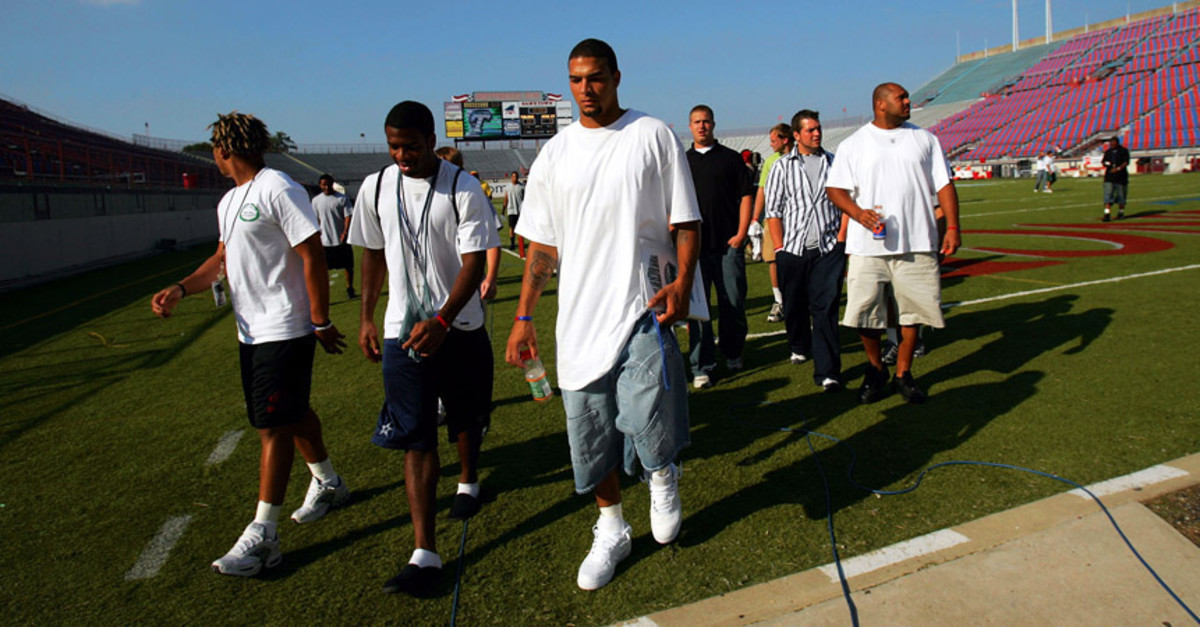
Ronald Martinez/Getty Images
Tulane didn't win a game after that trip into New Orleans. Over the course of the season it traveled 8,815 miles, and along the way it lost hope. "It was mental exhaustion," Ricard says. "You were fatigued mentally from all the travels and everything that had happened." Still, the quarterback emphasizes that he and his teammates never quit. Their circumstances smothered them. Without proper film, they couldn't adequately scout opponents. Without an official weight room or workout program, they fell flat on the field. With no nutritional plan, fat players got skinny and skinny players got fat. At some point the team lost its faith in the coaching staff. Some players felt they had too much freedom at the expense of football. Others saw coaches handling things poorly and taking out their frustrations on players. When Tulane lost to Rice, snapping the Owls' 14-game-losing streak, Scelfo left several key players behind with little explanation. "There was a weird dynamic there that we never overcame," Ricard says. "It sucked, to be honest with you, because we did have a good team that year. … And then this happens. Ten steps back, no steps forward."
After Tulane played its final game, on Nov. 26, 2005, players scattered, though not for long. Although much of New Orleans was still shut down in January, the school reopened. "We weren't going to run away," Forte says, "not because a hurricane or a storm shook us up." Still, campus had sustained nearly $200 million in damage and the athletic department had been gutted, literally and figuratively; its facilities were underwater, its equipment ruined, and the school cut eight of its 16 sports. (The NCAA granted it a waiver to do so and remain a Division I institution, as long as it brought the sports back in a timely manner.) The flooding also washed away the football program's files on potential recruits. If SMU hadn't sent over its database, the team would've been left with a blank slate and only four weeks to get players to its reopened campus. The Green Wave signed 24 players, 19 from outside Louisiana.
And then they rebuilt, New Orleans and Tulane. Some players, like Route, came away from Katrina with nothing but the possessions they'd purchased with gift cards in Ruston. But even though New Orleans took everything he owned, the Atlanta native returned—and stayed. He still lives there today, driving past the houses in Uptown and St. Bernard Parish that he helped to repair and rebuild with Habitat for Humanity in the months after the storm.
Route isn't the only one. Community service wasn't compulsory that spring, but players couldn't imagine not participating. "There was always something going on where you could help someone out," Parenton says. "It never was that you were just isolated, and the world is crashing in."
Many of the school's neighbors were still displaced, and favorite restaurants remained closed. Roofs were tarps, cars were rusted out and insurance checks weren't nearly enough. Jobs were scarce, and federal aid was a shaky proposition at best. Wishing New Orleans would return to what it once was wouldn't get players and staffers anywhere. "You never really had a chance to feel sorry for yourself," Stewart says. "Certainly there were times where you'd be like, we'd be [better] if not for it. But I think the people who felt sorry for themselves all left. Yeah, you had days when you cried. You'd go sit in your truck and go, 'What am I doing?' But at the end of your moment, you'd go back out there and ask, 'What's next?'"
In the decade since Katrina, Tulane has replaced its eight cut sports, reaching 16 in 2013, the same year the football team made its first bowl since '02. In the past six years the school has invested more than $150 million into new facilities, doing comprehensive renovations on both its baseball and basketball venues. In '14 it opened a new on-campus football stadium and moved to the American Athletic Conference, and in November Tulane will induct all of its athletes from the 2005-06 season into its athletic hall of fame, honoring the sacrifices they made 10 years ago. It's the school's way of saying thank you. Those months of isolation and chaos counted for something.
*****
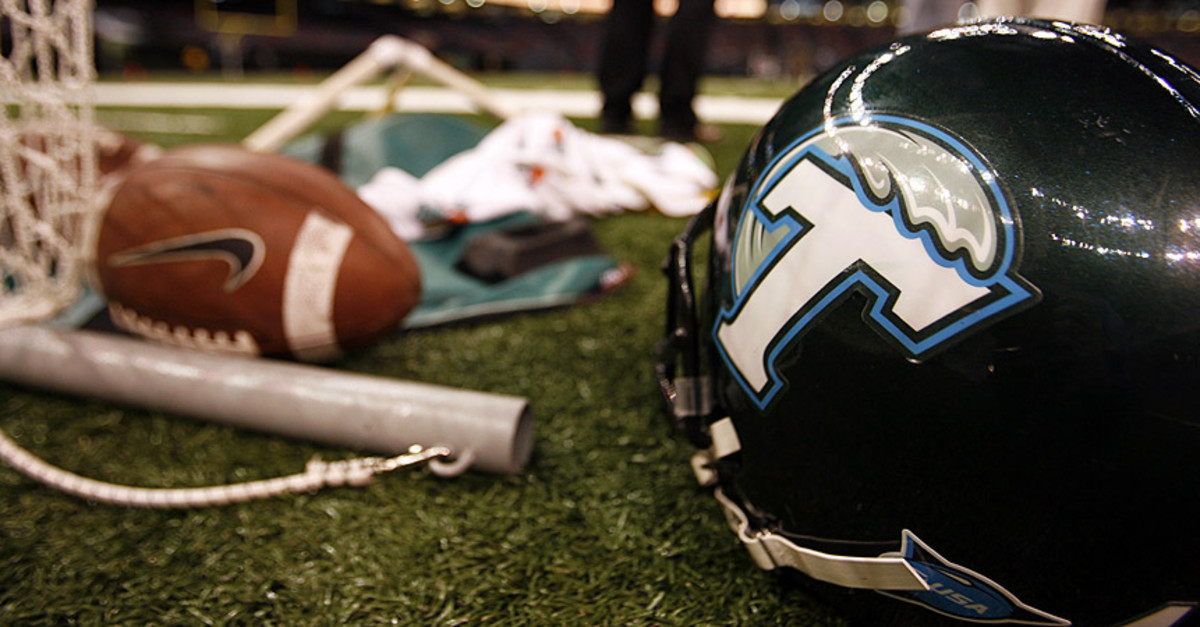
Mike Ehrmann/WireImage
New Orleans is a riddle: What's sunken and smelly, terrible for your health and sublime for your soul, what draws you in tight and feeds you full and makes you wonder if you might not be able to live off any other city's air? If you can solve it, you stay, or you spend your life wishing you had or could. If you can't, well, maybe you're one of those people who thought Katrina was some kind of modern judgment of Sodom and Gomorrah. Or maybe you just don't care what happens to this weird little swamp, where the West Bank is really south and the East Bank is north, where medians are called neutral grounds, white trash are Yats and streets are just parade routes that sometimes permit cars.
It's a place where you learn by doing, by winding up with your sandal drenched in a puddle of Bourbon Street piss water, by waking up with a saccharine hangover headache, by drinking tap water you later learn might have been contaminated. You don't ask questions. (Why should I suck the crawfish's head? Who dips eggplant in powdered sugar? Does the streetcar ever come on time? Do the cops arrest anyone?) Instead, you simply do. You suck and you dip and you wait and you hope you don't do anything that'll land you in the Orleans Parish Prison. Along the way, you'll find out all about the Rebirth Brass Band and turtle soup and general human decency, of which New Orleans has a mother lode to spare. No storm could wash that away.
In immediate aftermath of Katrina, Stewart, who relocated briefly to East Texas, bought a new cellphone with a 903 area code. His New Orleans number, area code 504, wouldn't work, and he needed to communicate, so he used his new flip phone until the New Orleans cell towers became functional. Today, the 903 phone remains plugged into his office wall. Though his friends tell him it's time to move on, the doctor pays a minimal monthly charge to keep it connected. "That's kind of that last vestige of Katrina that I'm not willing to give up," he says.
Kropog, too, has his own weird token of those months. Before Tulane's Oct. 21 game at UCF, the offensive lineman's alarm clock didn't sound. He'd just bought a new one at Wal-Mart, and its buzzer was faulty. That morning, he woke up to a dozen missed calls and barely made the bus. Now, six NFL seasons behind him, Kropog still has that clock.
These are Katrina's scars. They're subtle and fading, but scars nonetheless. In the early years after the storm, some preserved the Katrina crosses—spray-painted X's left by the National Guard that denoted such facts as date, time and dead bodies found—on the fronts of their homes, turning them into the most macabre of decor. But most sanded them away, as if it might help them forget the unforgettable. In some places it's possible. Uptown is rebuilt. The French Quarter saw little damage. St. Charles Ave., where Mardi Gras parades roll every spring, looks exactly as it always has. The angry graffiti and watermarks that taunted New Orleans— you're nothing more than a massive, drained bathtub—are easily scrubbed away.
But drive a little farther, due north from the Garden District, to Lakeview. The roads there are even worse than in the rest of New Orleans; sections of the neighborhood are sinking, more than 10 feet in the century since the city drained the swamp there. Along those same pockmarked streets some houses are jacked up eight feet in the air, awkwardly hovering over an invisible lake not a soul hopes to ever see filled again. From there, head east, to the Lower Ninth Ward, where pockets of homes have been razed and others haven't seen a shoe step on molding floorboards in a decade. Some residents deemed the land unfit to repopulate, and some couldn't afford repairs. Today, the Lower Ninth is silent, near abandoned, the kind of place that even in broad daylight will make you believe in ghosts.
New Orleans has changed, in large part for the better, in recent years. Outsiders have begun to make the city home and the population of the metro area has come within 100,000 of its pre-storm 1.3 million. "It's been cool seeing it, over the years, this long process, seeing it come back," Forte says. Neighborhoods not worth visiting before Katrina, like the Bywater and Marigny, are now bustling and trendy. Most of the city's famed restaurants are up and running: Beignets taste like beignets at Café Du Monde, hurricanes like hurricanes at Pat O'Brien's, po'boys like heaven at Domilise's. Still, the place feels different, a shade more cosmopolitan, a pinch more connected, a fraction less weird. "In a way, it's O.K. because you know that it's better than it was before," says Brian King, a Slidell, La., native who was a freshman receiver for Tulane in 2005. "But you know it's never going to be the same. The way New Orleans was before, it's indescribable."
That New Orleans is the reason players played. It's the city they couldn't imagine abandoning. Although Scelfo and Dickson say they're not sure they would make the decision to play if similar circumstances presented themselves a second time, the players disagree. Ricard says he wouldn't change a thing, and teammates echo that sentiment. Do they wish they'd never had to do it? Of course. But they're better men for it. "After that," King says, "I can take on anything."
Stewart's office today is in the same first-floor suite it occupied before Katrina. Sitting in a small conference room, the doctor contemplates a wall. "We'd be under three feet of water," he says, which relatively speaking isn't much—and rationally speaking is enough to ruin a life. But just as quickly as he has pondered his career's work submerged, he moves on. He'd do it again, rebuild again, he says. He'd endure a million more minor disasters if it meant returning to this place and preserving it, just as Tulane's players would lose a hundred more games in a hundred different stadiums for the sake of New Orleans.
"You go back," Stewart says. "That's who we were and what we did."
